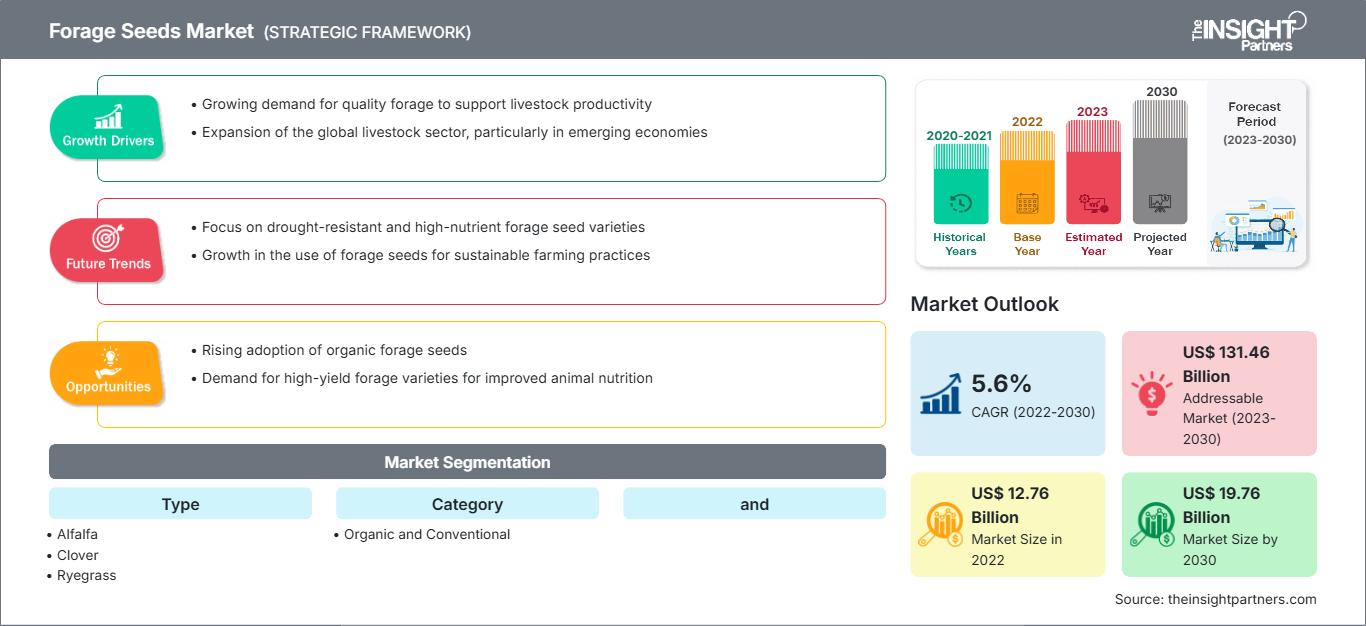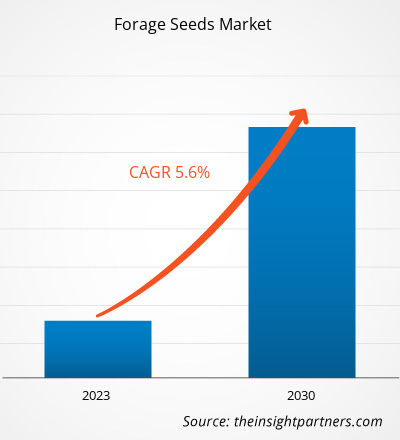[研究报告] 预计市场规模将从 2022 年的 127.57 亿美元增长到 2030 年的 197.5546 亿美元;预计 2022 年至 2030 年的复合年增长率为 5.6%。
市场洞察和分析师观点:
传统饲料通常含有大量化学物质,动物食用后会影响肉质。长期食用此类肉类会导致各种健康问题。为了解决这个问题,制造商正在开发不含化学添加剂的有机饲料。以这种饲料喂养的动物提供的肉类营养价值很高。因此,消费者通常认为有机和天然产品是比传统产品更健康的替代品。消费者主要倾向于有机产品,这促使制造商大力投资采用有机成分生产的产品。此外,借助互联网,消费者能够更便捷地获取海量信息,从而不断提升对自身健康需求的认识,进而带动对有机饲料的需求不断增长。因此,在预测期内,对有机饲料的偏好预计将成为牧草种子市场的一个重要趋势。
增长动力与挑战:
种子遗传学技术的进步为全球牧草种子市场的增长提供了机遇。随着技术的发展,种子制造商开发了不同品种或性状的种子,例如杂交种子、转基因种子、非转基因种子和有机种子。在各个牧草种植区,农民对这些转基因品种的偏好正在逐渐上升,以最大限度地减少杂草和疾病造成的作物损失,并提高种子的质量。杂交种子是通过对同一物种的两个不同亲本植物进行特殊的、精心控制的异花授粉而产生的,从而产生两种同种植物近亲繁殖无法产生的新性状。通常,杂交种子是通过人工异花授粉获得的。
转基因种子是通过基因工程改变生物体的遗传物质而产生的。转基因种子是利用现代生物技术在实验室中培育的。另一方面,非转基因种子是通过授粉培育的。有机种子被视为非转基因种子。有机种子是自然产生的,无需使用杀虫剂、化肥或任何其他化学物质。这些种子具有抗病能力,并能在恶劣条件下茁壮成长。
这些育种技术通过修改种子和植物细胞的DNA,可以培育出具有所需性状的新种子品种。这些技术进步有助于解决农民在牧草种子种植过程中面临的挑战。因此,预计持续的技术进步将在未来几年为牧草种子市场创造丰厚的利润。
自定义此报告以满足您的要求
您将免费获得任何报告的定制,包括本报告的部分内容,或国家级分析、Excel 数据包,以及为初创企业和大学提供超值优惠和折扣
牧草种子市场: 战略洞察

- 获取本报告的主要市场趋势。这个免费样本将包括数据分析,从市场趋势到估计和预测。
您将免费获得任何报告的定制,包括本报告的部分内容,或国家级分析、Excel 数据包,以及为初创企业和大学提供超值优惠和折扣
牧草种子市场: 战略洞察

- 获取本报告的主要市场趋势。这个免费样本将包括数据分析,从市场趋势到估计和预测。
报告细分和范围:
“全球牧草种子市场”根据类型、类别、牲畜和地域进行细分。根据类型,牧草种子市场细分为[苜蓿、三叶草(白三叶草、红三叶草、杂交三叶草及其他)、黑麦草(一年生黑麦草、多年生黑麦草、意大利黑麦草和杂交黑麦草)、猫尾草、高粱、雀麦、百脉根、豇豆、草甸羊茅及其他]。根据类别,市场细分为有机和常规。根据牲畜,牧草种子市场细分为反刍动物、家禽、猪及其他。根据地域划分,牧草种子市场分为北美(美国、加拿大和墨西哥)、欧洲(德国、法国、意大利、英国、俄罗斯和欧洲其他地区)、亚太地区(澳大利亚、中国、日本、印度、韩国和亚太其他地区)、中东和非洲(南非、沙特阿拉伯、阿联酋和中东和非洲其他地区)以及南美洲和中美洲(巴西、智利和南美洲和中美洲其他地区)。
分段分析:
根据牲畜,牧草种子市场分为反刍动物、家禽、猪和其他。反刍动物在 2022 年占据了牧草种子市场的最大份额,预计在预测期内将实现显著增长率。反刍动物包括牛、绵羊、山羊和水牛。牧草是反刍动物蛋白质、纤维和能量的主要来源。豆科牧草,例如苜蓿和三叶草,为反刍动物提供了75%的粗蛋白。牧草还能为反刍动物提供大量的纤维。此外,牧草还能降低瘤胃饲料的总成本。因此,畜牧养殖者通常将牧草与动物饲料一起使用。人们对反刍动物(尤其是奶牛、山羊、绵羊和肉牛)特定营养的认识日益提高,这推动了对牧草的需求,从而推动了牧草种子市场的增长。
区域分析:
根据地域分布,牧草种子市场分为五个主要区域——北美、欧洲、亚太地区、南美和中美以及中东和非洲。全球牧草种子市场以北美为主,预计 2022 年市场规模约为 50 亿美元。由于饲料对牧草的需求增加、肉类消费和天气条件,以及尽管价格上涨、动物饲料和农业产业成熟,牲畜产品消费仍在增加,北美是牧草种子的重要市场之一。越来越多的人选择富含蛋白质和更健康的产品,可支配收入增加、生活方式改变和饮食模式改变,导致美国、加拿大和墨西哥对富含蛋白质的肉类的需求激增。因此,随着肉类产品消费量的增加,对动物饲料的需求也增加,并进一步推动了牧草种子市场的发展。该地区是该地区最大的动物饲料生产国之一。根据 Alltech Global 的报告,2020 年该地区生产了超过 2.54 亿公吨的动物饲料产品。北美大量生产动物饲料,加上人们对食品安全(尤其是肉类和奶制品安全)的担忧日益加剧,导致该地区对牧草等营养动物饲料的消费量增加。
北美养牛业的大幅增长也有望在预测期内推动对牧草等动物饲料的需求。例如,根据 Foothills Forage & Grazing Association 的数据,2021 年 7 月 1 日加拿大牛存栏量为 1229 万头,比 2020 年 7 月 1 日增加 0.2%。这一增长归因于对新鲜肉类产品的需求不断增长,导致牛畜进口量激增。此外,根据美国农业部 (UDSA) 的报告,2021 年北美地区的牛存栏量超过 1.14 亿头,生猪存栏量超过 1.09 亿头。因此,不断增加的牛存栏量和对健康动物饲料的需求推动了整个地区对牧草种子的需求。
行业发展和未来机遇:
牧草种子市场主要参与者采取的各种举措如下:
- 2022 年 11 月,全球可持续农业解决方案提供商 UPL Ltd. 宣布,其公司 Advanta Seeds UK 和邦吉已签署协议,分别收购 SEEDCORP|HO 20% 的股份。此次意向投资是UPL集团OpenAg目标的一部分,旨在推动合作,为农民提供一整套解决方案。
- 2022年10月,全球投资公司KKR与全球农业解决方案提供商UPL有限公司宣布签署最终协议,KKR将投资3亿美元收购UPL有限公司子公司Advanta Enterprises Limited 13.33%的股份。
新冠疫情的影响:
新冠疫情影响了各国的经济和行业。北美、欧洲、亚太地区(APAC)、南美和中美(SAM)以及中东和非洲(MEA)主要国家的旅行禁令、封锁和企业停工对包括农业和动物饲料行业在内的各行各业的增长产生了负面影响。生产部门的停工扰乱了全球供应链、交付计划、生产活动以及各种必需和非必需产品的销售。多家公司宣布,2020年产品交付可能出现延迟,其产品未来销量也可能出现下滑。此外,欧洲、亚洲和北美各国政府实施的国际旅行禁令,迫使各公司暂时搁置了合作计划。所有这些因素都阻碍了2020年和2021年初动物饲料行业的发展,从而抑制了牧草种子市场的增长。
牧草种子牧草种子市场区域洞察
牧草种子市场区域洞察
The Insight Partners 的分析师已详尽阐述了预测期内影响牧草种子市场的区域趋势和因素。本节还讨论了北美、欧洲、亚太地区、中东和非洲以及南美和中美洲的牧草种子市场细分和地域分布。
牧草种子市场报告范围
| 报告属性 | 细节 |
|---|---|
| 市场规模 2022 | US$ 12.76 Billion |
| 市场规模 2030 | US$ 19.76 Billion |
| 全球复合年增长率 (2022 - 2030) | 5.6% |
| 历史数据 | 2020-2021 |
| 预测期 | 2023-2030 |
| 涵盖的领域 |
By 类型
|
| 覆盖地区和国家 | 北美
|
| 市场领导者和主要公司简介 |
|
牧草种子市场参与者密度:了解其对业务动态的影响
牧草种子市场正在快速增长,这得益于终端用户需求的不断增长,而这些需求的驱动因素包括消费者偏好的演变、技术进步以及对产品优势的认知度不断提高。随着需求的增长,企业正在扩大产品线,不断创新以满足消费者需求,并抓住新兴趋势,从而进一步推动市场增长。

- 获取 牧草种子市场 主要参与者概述
竞争格局和主要公司:
UPL Ltd、DLF Seeds AS、Corteva Inc、Limagrain UK Ltd、S&W Seed Co、Deutsche Saatveredelung AG、Cerience、Allied Seed LLC、MAS Seeds SA 和 Syngenta AG 是全球牧草种子市场的领军企业。这些牧草种子制造商提供具有创新功能的尖端种子解决方案,为农民及其牲畜带来卓越的体验。
- 历史分析(2 年)、基准年、预测(7 年)及复合年增长率
- PEST和SWOT分析
- 市场规模、价值/数量 - 全球、区域、国家
- 行业和竞争格局
- Excel 数据集
近期报告
相关报告
客户评价
购买理由
- 明智的决策
- 了解市场动态
- 竞争分析
- 客户洞察
- 市场预测
- 风险规避
- 战略规划
- 投资论证
- 识别新兴市场
- 优化营销策略
- 提升运营效率
- 顺应监管趋势




















 获取免费样品 - 牧草种子市场
获取免费样品 - 牧草种子市场